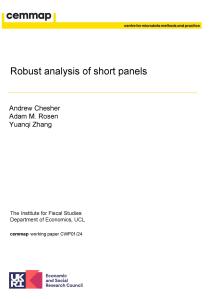Quasi-experimental designs are gaining popularity in epidemiology and health systems research – in particular for the evaluation of healthcare practice, programs and policy – because they allow strong causal inferences without randomized controlled experiments. We describe the concepts underlying five important quasi-experimental designs: Instrumental Variables, Regression Discontinuity, Interrupted Time Series, Fixed Effects, and Difference-in-Differences designs. We illustrate each of the designs with an example from health research. We then describe the assumptions required for each of the designs to ensure valid causal inference and discuss the tests available to examine the assumptions.
Authors: Till Bärnighausen, Catherine Oldenburg, Peter Tugwell, Christian Bommer, Cara Ebert, Mauricio Barreto, Eric Djimeu, Noah Haber, Hugh Waddington, Peter Rockers, Barbara Sianesi, Jacob Bor, Günther Fink, Jeffrey Valentine, Jeffrey Tanner, Tom Stanley, Eduardo Sierra, Eric Tchetgen Tchetgen, Rifat Atun, Sebastian Vollmer.








